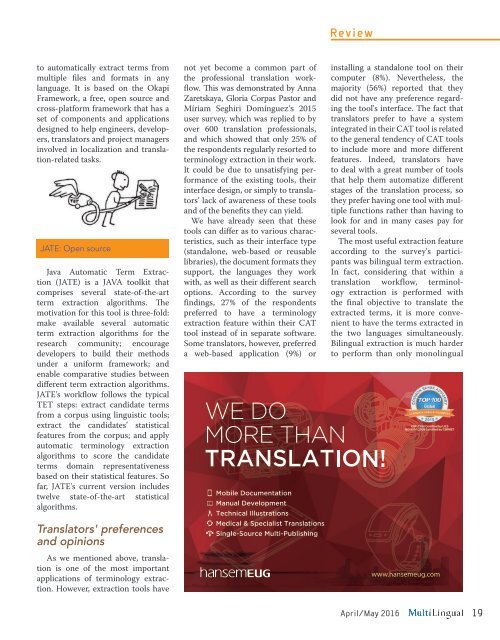Localization
z99kl79
z99kl79
Create successful ePaper yourself
Turn your PDF publications into a flip-book with our unique Google optimized e-Paper software.
Review<br />
to automatically extract terms from<br />
multiple files and formats in any<br />
language. It is based on the Okapi<br />
Framework, a free, open source and<br />
cross-platform framework that has a<br />
set of components and applications<br />
designed to help engineers, developers,<br />
translators and project managers<br />
involved in localization and translation-related<br />
tasks.<br />
JATE: Open source<br />
Java Automatic Term Extraction<br />
(JATE) is a JAVA toolkit that<br />
comprises several state-of-the-art<br />
term extraction algorithms. The<br />
motivation for this tool is three-fold:<br />
make available several automatic<br />
term extraction algorithms for the<br />
research community; encourage<br />
developers to build their methods<br />
under a uniform framework; and<br />
enable comparative studies between<br />
different term extraction algorithms.<br />
JATE's workflow follows the typical<br />
TET steps: extract candidate terms<br />
from a corpus using linguistic tools;<br />
extract the candidates’ statistical<br />
features from the corpus; and apply<br />
automatic terminology extraction<br />
algorithms to score the candidate<br />
terms domain representativeness<br />
based on their statistical features. So<br />
far, JATE's current version includes<br />
twelve state-of-the-art statistical<br />
algorithms.<br />
Translators' preferences<br />
and opinions<br />
As we mentioned above, translation<br />
is one of the most important<br />
applications of terminology extraction.<br />
However, extraction tools have<br />
not yet become a common part of<br />
the professional translation workflow.<br />
This was demonstrated by Anna<br />
Zaretskaya, Gloria Corpas Pastor and<br />
Míriam Seghiri Domínguez's 2015<br />
user survey, which was replied to by<br />
over 600 translation professionals,<br />
and which showed that only 25% of<br />
the respondents regularly resorted to<br />
terminology extraction in their work.<br />
It could be due to unsatisfying performance<br />
of the existing tools, their<br />
interface design, or simply to translators’<br />
lack of awareness of these tools<br />
and of the benefits they can yield.<br />
We have already seen that these<br />
tools can differ as to various characteristics,<br />
such as their interface type<br />
(standalone, web-based or reusable<br />
libraries), the document formats they<br />
support, the languages they work<br />
with, as well as their different search<br />
options. According to the survey<br />
findings, 27% of the respondents<br />
preferred to have a terminology<br />
extraction feature within their CAT<br />
tool instead of in separate software.<br />
Some translators, however, preferred<br />
a web-based application (9%) or<br />
installing a standalone tool on their<br />
computer (8%). Nevertheless, the<br />
majority (56%) reported that they<br />
did not have any preference regarding<br />
the tool's interface. The fact that<br />
translators prefer to have a system<br />
integrated in their CAT tool is related<br />
to the general tendency of CAT tools<br />
to include more and more different<br />
features. Indeed, translators have<br />
to deal with a great number of tools<br />
that help them automatize different<br />
stages of the translation process, so<br />
they prefer having one tool with multiple<br />
functions rather than having to<br />
look for and in many cases pay for<br />
several tools.<br />
The most useful extraction feature<br />
according to the survey's participants<br />
was bilingual term extraction.<br />
In fact, considering that within a<br />
translation workflow, terminology<br />
extraction is performed with<br />
the final objective to translate the<br />
extracted terms, it is more convenient<br />
to have the terms extracted in<br />
the two languages simultaneously.<br />
Bilingual extraction is much harder<br />
to perform than only monolingual<br />
ISO17100 Certified by LICS<br />
ISO 9001:2008 Certified by CERMET<br />
www.hansemeug.com<br />
April/May 2016<br />
19


